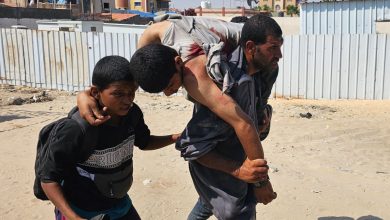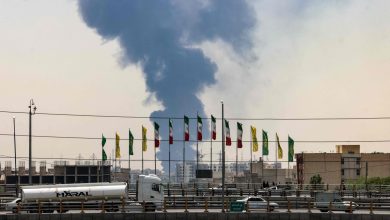Unveiling key details of bomb used by Israel in Gaza’s ‘safe zone’

[ad_1]
Israel’s devastating strike on al-Mawasi, marking one of the deadliest attacks in over nine months of conflict in Gaza, utilized massive payload bombs supplied by the U.S., according to weapons experts.
The bombing turned the Israeli-declared “safe zone,” a tent city on the Mediterranean coast, into a charred wasteland, overwhelming nearby hospitals with casualties.
The Health Ministry in the Hamas-administered territory reported at least 92 fatalities and over 300 injuries from the assault.
The Israeli military said it targeted two “masterminds” of the Oct. 7 attacks by Hamas that triggered the latest conflict.
It said a top commander, Rafa Salama, was killed in the strike, but uncertainty remains over Hamas military chief Mohammed Deif.
Videos of the attack showed a white mushroom cloud billowing over a busy street, leaving behind a huge crater strewn with the wreckage of tents and a building blown to bits.
Here is what we know about the weaponry used in the attack.
U.S.-made JDAM
Two weapons experts told Agence France-Presse (AFP) that a sliver of munition seen in a video of the blast site circulating online was a tail fin from a U.S.-made Joint Direct Attack Munition (JDAM).
The GPS-aided kit converts unguided free-fall bombs – so-called “dumb bombs” – into precision-guided “smart” munitions that can be directed toward single or multiple targets.
The U.S. developed the kit to improve accuracy in adverse weather after Operation Desert Storm in 1991.
The first JDAMs were delivered in 1997 and, according to the U.S. Air Force, have a 95% system reliability.
Trevor Ball, a former U.S. Army explosive ordnance disposal technician, concluded from images of the Al-Mawasi strike, “It’s 100% a JDAM kit made in the United States.”
He said that given the types of bombs compatible with the guidance system and the size of the fin fragment, the JDAM was most likely used with either a 1,000- or 2,000-pound (450- or 900-kilogram) payload.
He said the fragment could also be compatible with the BLU-109 “bunker buster” warhead, which is designed to penetrate concrete.
Ball said it was not possible to definitively determine where the payload itself was made without “very specific fragments of the bomb body.”
New delivery
Repeated use of such large bombs in the densely populated Gaza Strip has sparked humanitarian outcry and heaped pressure on U.S. President Joe Biden to reconsider the munitions supplied to Israel.
On July 12, Israel’s main military backer announced it was ending a pause on supplying 500-pound bombs, though Biden said the 2,000-pound type would be withheld.
The White House has repeatedly voiced frustration over the civilian death toll in Gaza as Israel attempts to eradicate Hamas.
U.S. Secretary of State Antony Blinken told two top Israeli officials on Monday that the civilian toll was “unacceptably high,” his spokesman said.
Israeli officials said their “precise strike” in Al-Mawasi hit an open area that housed a Hamas compound and not a civilian camp.
When contacted by AFP regarding the weapons used, the Israeli military declined to comment.
Based on Israel’s stated target, Wes Bryant, a retired U.S. Air Force master sergeant and strike and joint targeting expert, said it would have been feasible to avoid collateral damage in the surrounding area.
“My assessment is that any civilians killed in this strike were in the compound – not in the surrounding vicinity. So the IDF either failed to assess the presence of civilians or deemed the risk to civilians proportional to the military advantage of taking out the Hamas leaders.”
Absolute destruction
The strike left al-Mawasi a scene of “absolute destruction” with no water, electricity or sewage treatment, the Islamic Relief charity said.
It condemned Israel for its willingness “to kill innocent men, women, and children in pursuit of its end goals.”
Hamas said that by arming Israel, the Biden administration is “legally and morally responsible” for spawning a “major humanitarian catastrophe.”
It said U.S.-supplied weapons used by Israel included GPS-guided bombs, dumb bombs, bunker busters, and JDAMs.
After repeated high-casualty strikes in recent days, a Hamas official said the group was withdrawing from indirect talks for a truce and hostage release deal with Israel.
The war was sparked by Hamas’ Oct. 7 incursion on Israel, which resulted in the deaths of 1,195 people.
Israel responded with a military offensive that has killed at least 38,664 people in Gaza.
[ad_2]
Source link






